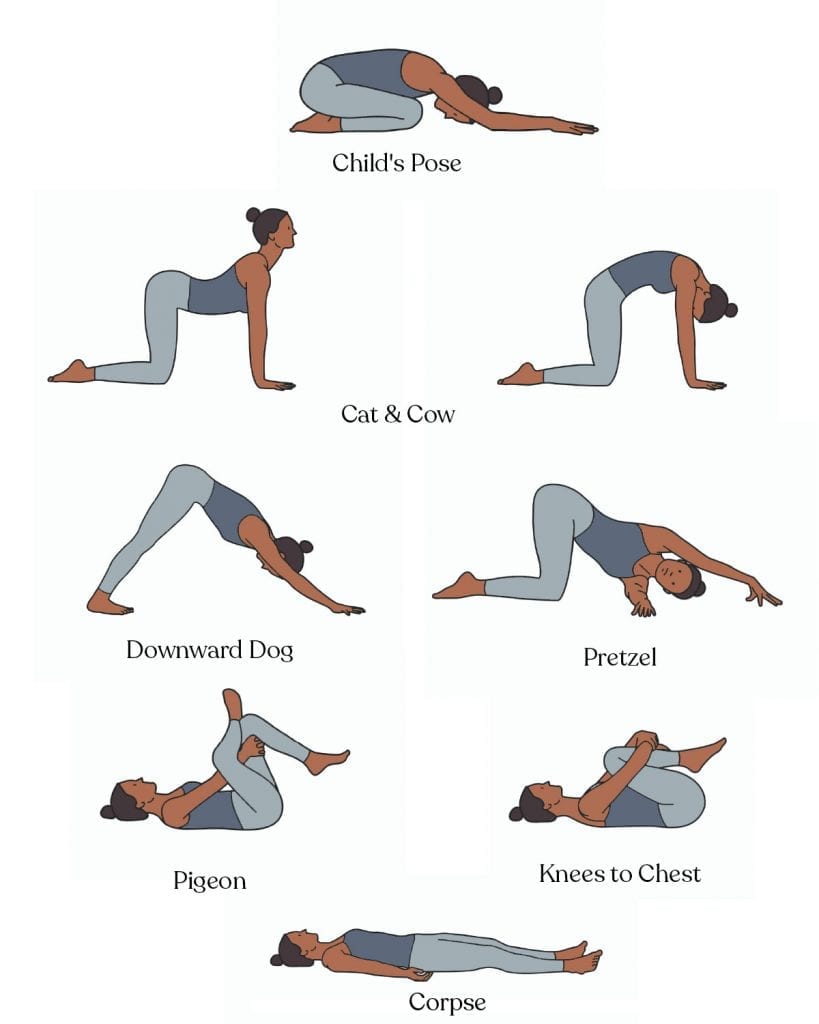These seven yoga poses serve two purposes, the first being to release physical tension throughout your body, and the second being to use the poses as an opportunity to go inward.
Going inward could mean meditation, if that’s something you are comfortable practicing independently, but going inward could also be thought of as asking yourself: where am I at? what is bothering me? why am I feeling this way? etcetera.
“The mind is the king of the senses, but the breath is the king of the mind.”
– Hatha Yoga Pradipika
The following yoga poses are in sequence order, so that you may try them out at home and pace your very own de-stressing yoga break. Please remember to breathe, as any one of these postures can be practiced independently in times of anxiousness; “The mind is the king of the senses, but the breath is the king of the mind.” (from the Hatha Yoga Pradipika)
Yoga Poses To Let Go Of Tension

1. Begin In Child’s Pose
1. Child’s Pose (Balasana): Begin in child’s pose. This posture relaxes the spine, especially the lower back, and even the neck. Child’s Pose is to the beginning of a flow what Shavasana is to the end of a flow; it will get you into that mindset of sheer relaxation.
2. Cat & Cow Yoga Poses For Stretching
2. Cat (Marjaryasana) and Cow (Bitilasana): These two postures go to together like salt and pepper; you can’t really have one without the other. While the Cow pose will elongate the front of your body, stretching out your abdomen and the front of your neck (or thyroid), cat pose will elongate the spine, alleviating pain in the lower back. If you concentrate on really pushing your hands down into the ground, these two postures will also benefit your shoulder muscles, where the body holds most of our stress.
3. Downward Dog For Grounding
3. Downward Dog (Adho Mukha Shvanasana): Downward Dog is to yoga like the sun is to the planets; it’s basically at the center of the asanas. But it should not be underestimated in its simplicity. Downward Dog is considered a head inversion posture, where the heart is above the head (quite symbolic indeed), allowing you to alter your blood flow, bringing oxygen to the brain. In particular, this posture relaxes the neck. And gain, if you really push your hands down into the ground, your shoulder muscles will thank you for it.
4. Pretzel Pose For Your Shoulders
4. Shift back to hands and knees and do the “Pretzel” (or “Thread the Needle,” Parsva balasana), on each side: This one is for your shoulders. It is an upper body twist and gentle inversion. Be sure that you are resting your weight on your shoulder and not your neck in this posture. I cannot stop calling this posture the “Pretzel,” because my very own grandmother giggled herself to tears in her first yoga class with me, because she declared that “she was twisted like a pretzel,” but I promise, your body will love becoming a pretzel.
5. Pigeon Yoga Pose To Release
5. Pigeon (Kapotasana): This posture is for your hips, where I was first told by a fellow yogi, we hold our anger. Are you angry about anything? If you think you are not, see how you feel after five minutes in Pigeon on each side. Whether or not you thought you were “holding anger,” I’d bet a good dinner that afterward you’ll feel much lighter in spirit.
6. Knees To Chest For Alignment
6. Knees to Chest (Apanasana), on your back: This posture is as comforting as a child’s best stuffed friend at bedtime. You will relax the spine, and you may even experience a “cracking” or adjustment here: that’s your spine aligning itself. It is your lower back, though, that gets the attention, so if you suffer from lumbar pain, this is my number one recommendation. For an even deeper stretch, try tucking your hands in between your thighs and calves and crossing your ankles.
7. Corpse Pose For Relaxation
7. Shavasana (or Corpse Pose): This posture is meant to provide you a platform for ultimate relaxation, effective meditation, and mental clarity. Begin by letting your arms rest at your sides and your feet fall open; then concentrate on relaxing every muscle in your body from your head down to your toes, even the muscles you don’t tend to think about, such as in your face and in your fingers and toes. At the end of my own classes, I would prompt students to first wiggle their fingers and toes, bringing motion back to the body, and then place one hand on the heart and the other on your stomach and think of what you are most grateful for.
If I was able to teach an in-person class now though, during the pandemic, I would say, “Make a mental list of everything you still have.” It can be easy to think of what we miss right now, but why not flip that and think of what is left. What about books, languages to learn, a good night’s rest, or the beauty in the changing of seasons?
Namaste




